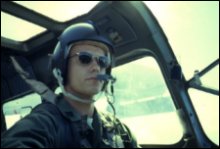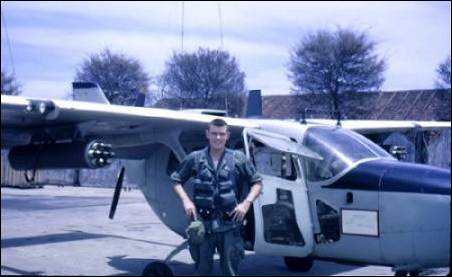
Home
FACs
More About FACs
The AO
A Shau Valley
• A Shau SF Camp
Hué
• Hué Cit Airfield
• MACV Compound
• LCU Ramp
• Hué Goose
Battle of Hué (Tet 1968)
• Trail FACs
The Missions
Visual Recon
• Sunken Sampan
Close Air Support
• CAS Munitions
• Rules of Engagement
• TACS
• Battle at Hua Cu
Interdiction
• McNamara Line
• Choke Points
Ranch Hand
Trail Dust Mission
Arc Light
SAR
Hammer 51 Rescue
Search for Jolly 23
• Msn Reports
• Search Area Map
• Search Rejoined
• Link to Past
Jungle Penetrator
Legacies
Aircraft
O-2A
Glossary
Resources
Contact
Return to Top
|

| |
The photo above gives a close look at the O-2A and the equipment some FACs flew with during this period.
I am wearing the standard Air Force mesh survival vest with pockets for a first aid kit, flares and (most important!) an emergency radio and extra battery.
I preferred the Army-issue jungle fatigues over the USAF cotton flying suit (NOMEX was not around then).
The fatigues were made of a blended rip-stop material and were very comfortable.
They also had lots of well-designed pockets. Most important, they made you look like a grunt.
FACs drew special attention from the VC, and we did not want to make their targeting job any easier as we moved about on the ground.
Most of us believed in the basic jungle survival rule of blending in with the crowd.
Most of my detachment wore an issue
M69 flak vest (Kevlar body armor) when outside our compound and while flying.
 |
| AFH-1 Flight Helmet |
Many FACs also sat on a spare vest in the airplane to provide additional protection from below.
In flight, we wore the then-new AFH-1 flight helmet.
This helmet was heavier than the previous aircrew protective helmet, but it offered a higher degree of protection against small arms and fragments.
Most FACs carried an
M-16 rifle. This was for personal protection while on the ground or in the event of an emergency landing.
Some also used it for fire support against ground targets, but the accuracy of this was questionable.
This tactic may have worked in the O-1, but the small window opening on the pilot's side of the O-2 limited its effectiveness.
You also had to be careful that the ejecting brass did not break any of the glass instrument faces!
All in all, this was not a good idea.
There were racks for two M-16s on the cockpit walls behind the pilot, and the Dash One (pilot's manual) listed these weapons as the defensive armament for the aircraft.
 |
| M-16A1 Rifle |
I carried a special version of the M-16 officially known as the
XM177 but sometimes referred to by its civilian name, the
CAR-15. This version featured a telescoping stock and short barrel that made it easy to handle inside a cramped cockpit.
 |
|
| XM177 Carbine |
|
One drawback is that it was a hot item for individuals looking for something different, so you had to keep an eye on it all the time -- not a bad idea for any weapon.
I also carried a .38 caliber
Smith & Wesson Combat Masterpiece six-shot revolver, the standard Air Force aircrew sidearm.
Most in-country FACs did not wear parachutes.
At the low altitudes at which we operated, there would have been little opportunity to use one.
Most of us felt that our odds were better taking our chances to put the airplane down on a road or in a field, an option not available to pilots of jet aircraft.
Also, the position of the exit door on the O-2 across the cockpit made it cumbersome to leave the aircraft even on the ground.
Add the presence of the rear propeller in the bailout trajectory, and you can see why many of us had decided to stay with the bird.
Since my experience prior to the FAC assignment had been in tactical transports (C-130s), I was assigned to support Free World forces.
My administrative unit was the 20th Tactical Air Support Squadron (20th TASS) in Da Nang, but I was attached to Military Assistance Command, Vietnam (MACV) Advisory Team 3 that supported the
1st ARVN division headquartered in Hué.
Our area of operations was in the northern two provinces of South Vietnam (northern I Corp) and ran from just north of Da Nang to the DMZ (demilitarized zone) separating North and South Vietnam.
FAC Missions
Area of Operations
Return to Top
|
| |
|





